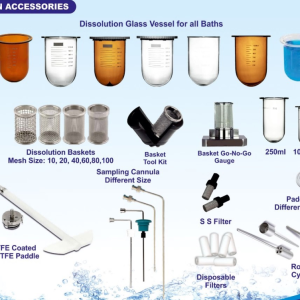IN-SITU FIBER OPTIC UV FOR DISSOLUTION TESTING – DISTEK
Model: Opt-Diss 410
Manufacturer: Distek, Inc.
Origin: USA
Features:
- Simple and efficient dissolution testing
- Automated data collection and analysis proceed from test to report in real-time, requiring no operator interaction.
- Data can be collected as frequently as every 5 seconds with no extra effort.
- Multicomponent analysis
- Measures two components in the same dissolution test without requiring LC.
- Suitable for products with two active pharmaceutical ingredients (APIs), excipients, coatings, or any source of UV spectrum deviations.
- Rapid and routine data collection
- Acquisition speeds as fast as 5 seconds for all vessels, enabling near real-time dissolution profiles.
- Ideal for understanding complicated release dynamics during formulation.
- Industry-approved technology
- Adopted by leading pharmaceutical companies, FDA, and USP.
- In-situ UV measurements
- Measurements are performed directly in the vessel, eliminating the need for manual or automated sampling along with associated consumables, labor, and off-line analysis.
- Choose from patented ARCH probes for negligible hydrodynamic impact or the Variprobe Adjustable Pathlength Dip Probe to easily switch between 2 mm, 5 mm, 10 mm, and 20 mm pathlengths.
- Single software package
- Fully integrated, 21 CFR Part 11 compliant UV fiber optic dissolution solution with a unified software package controlling the entire system.
Specifications:
| Parameter | Specification |
| Compliance | 21 CFR Part 11 |
| Light source | Deuterium lamp |
| Detector | Scientific grade CCD optimized for UV |
| UV range | 200 – 405 nm ± 5 nm |
| Wavelength accuracy | ± 2 nm or better |
| Channel capacity | Up to 12 channels |
| Probe types | ARCH probes, Variprobes, and dip probes |
| Probe pathlength | ARCH: 0.25 mm to 10 mmVariprobe: 2 mm to 20 mm |
| Spectra collection | As fast as every 5 seconds |
| Absorbance range | 0 – 2.0 AU |
| Stray light | <1% |
| Short-term noise | ± 0.002 AU (100 seconds at 250 nm) |
| Long-term noise | ± 0.005 AU (1 hour at 250 nm) |
| Compatible dissolution instruments | Distek models 2500, 2500 RTD, 2500 Select, Evolution 6100/6300, Symphony 7100 |
| Lab temperature | 20°C – 25°C |
| Lab humidity | 20% – 80% relative humidity |
| Electrical power | 115 – 230V ± 15V, 50/60 Hz, 10A |
| Weight | 25 kg |
| Dimensions | 33 cm (w) x 57 cm (h) x 56 cm (d) |










